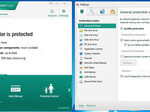Late 2012 is a good time to buy a Windows 7 laptop because they are still available. Also, you might not yet want Windows 8. Of course, if you wish, you can upgrade your laptop to Windows 8 later.
Author’s Note: I have recently purchased a new Windows 7 laptop. It is a relatively-inexpensive, basic model. I am not specifying which brand and model I chose because I this document applies to all new Windows 7 laptops.
This document can help you:
- Set up your laptop software.
- Protect your laptop against malware.
- Configure your laptop boot order.
- Configure your laptop battery.
For more information about setting up Windows 7, see Seven simple steps for setting up Windows 7.
Setting Up Your Laptop Software
To set up your laptop software, you need to configure Windows 7 updates, update Windows 7, and update your laptop manufacturer’s software.
Configuring Windows 7 Updates – To configure your laptop’s Windows 7 updates, do the following:
- Click “Start,” click “All Programs,” click “Windows Update,” and then click “Change settings.”
- Under Important updates, select “Check for updates but let me choose whether to download and install them.”
- Click “OK” to save your update settings.
Notes:
- I do not recommend automatic Windows 7 updates because they can cause you to miss your afternoon train. If you try to shut down your laptop at the end of the day, it might first make you wait until it finishes configuring its Windows 7 updates.
- Update Windows at least once each month; after each Patch Tuesday, which is the second Tuesday in each month.
Updating Windows 7 – To update your laptop’s Windows 7 operating system, do the following:
- Click “Start,” click “All Programs,” click “Windows Update,” and then click “Check for updates.”
- Install all available, important updates.
- If optional updates are available, select those you want, and then install them.
Note: After you update Windows 7, it might prompt you that you need to restart your laptop.
Updating Manufacturer’s Software – To update the software provided by your laptop manufacturer, follow the instructions in its online documentation. You can uninstall software that you will never use, such as a trial application that expires after a short interval if you do not buy its license.
Note: Be careful to not uninstall any software that you might later need.
Protecting Against Malware
To protect your laptop against viruses and other malware threats, you need only Microsoft Security Essentials (MSE). You can save money because you need no other anti-malware software. To download and install MSE, do the following:
- Go to the Microsoft Security Essentials download page.
- Select your Windows 7 version, 32-bit or 64-bit.
- Click “Download” and wait until it finishes.
- Go to your downloads folder, and double-click the “mseinstall.exe” file to install MSE.
- Click “Start,” click “All Programs,” and then click “Microsoft Security Essentials” to display its window.
- Use the tab pages to configure MSE and schedule its scans. Make sure that you enable real-time protection.
Configuring Your Laptop Boot Order
If you have configured your laptop boot order correctly, you can place a disc (such as a system-recovery disc) into your laptop optical drive, and then boot through that disc. To configure your laptop’s boot order, do the following:
- Search for the online manufacturers users’ guide for your your laptop. Hint: Windows 7 online help can help you find your users’ guide.
- Open your users’ guide.
- Press “Ctrl + F” to display a search window, type “boot” into it, and then press “Enter” to display its first usage.
- Use find next (F3) to find text relative to “boot order” or “boot sequence.” Repeat this step until you find instructions for configuring (or changing) the boot order.
Calibrating Your Laptop Battery
Calibrating your laptop battery can extend its life, and provide more-accurate remaining-capacity readouts. To calibrate your laptop’s battery, do the following:
- Fully charge the battery and then disconnect the charger.
- Set all power-management options so that they “never” shut down the laptop to conserve battery power.
- Discharge the battery until its low level shuts down your laptop. Note: Before your battery is low enough to shut down your laptop, close all open files and applications.
- After the low battery shuts down your laptop, reconnect its charger.
Source:
WIN7EBOOKS, “Seven simple steps for setting up Windows 7”, win7ebook.com






